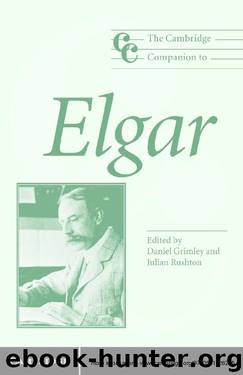The Cambridge Companion to Elgar (Cambridge Companions to Music) by The Cambridge Companion To Elgar (2004)

Author:The Cambridge Companion To Elgar (2004)
Language: eng
Format: epub
Publisher: Cambridge University Press
Published: 2005-01-06T02:00:00+00:00
The Welsh tune emerges on the solo viola from within the quartet. Significantly, the viola’s delicate inner timbre is only gradually joined by other members of the ensemble until a second tutti statement begins five bars after fig. 3, but the melody fails to reach its expected point of cadential arrival. Instead, the tune evaporates on the mysterious sustained D chord four bars before fig. 5, so that the reprise of the opening introductory gesture sounds very much like a brutal return to reality and the musical ‘present tense’ of the home key. The introduction closes with a brief epilogue that mourns the passing of the Welsh tune with a descending chromatic bass line.
Hans Keller has drawn attention to the synthesised ‘folky’ character of the Allegro’s first subject, with its pentatonic colouring.16 The music’s tight motivic integrity and ‘open string’ character emphasise the fresh start after the wistful ending of the introduction. The Allegro again exploits the dialogue between solo quartet and full ensemble, but the expected arrival of the Welsh tune as lyrical second subject, Hepokoski observes, is replaced by a new block of music, beginning with the busy semiquaver passage at fig. 10. This is one of the most noteworthy passages in Elgar’s music: a Sibelius-like episode of gestational activity, a creative flux out of which a figure of structural importance seems destined to emerge. Despite the energetic knees-up from fig. 12 and virtuoso brilliance of the following scale figuration, however, the sense of arrival is delayed until the heroic apotheosis of the Welsh tune in the reprise, where the music gathers itself together in a radiant tutti. For the time being, the music is left with merely a glimpse of the tune that signals closure, similar to the end of the introduction, which sounds all the more poignant for its formal absence.
The contrapuntal middle section, which Elgar described to Jaeger as ‘no working-out part but a devil of a fugue instead’,17 returns to the austere present tense of the opening bars, foregrounding the neo-Baroque idiom which underpins the work. Julian Rushton has persuasively discussed the form and historical context of the fugue.18 As with the introduction, the passage is not intended to recreate a Baroque fugue in a literal stylistic sense. Its intervallic angularity suggests rather an attempt to write an objective modern fugue and to create a new kind of modernist contrapuntal syntax. Structurally, Elgar’s fugue can be compared with the two fugal passages in the finale of Carl Nielsen’s Fifth Symphony (1920–2), which similarly serve as ‘substitutes’ for the expected development or ‘working-out’ section. Significantly, given the textural dialogue that motivates the work, the solo quartet does not actively partake in the fugal argument by playing the subject until a relatively late stage, at the rugged climax at fig. 19. Their first entry is a statement of the bass line from three bars after fig. 1, which forms an increasingly prominent countermelody as the fugue develops (Ex. 9.3). The main body of the fugue is
Download
This site does not store any files on its server. We only index and link to content provided by other sites. Please contact the content providers to delete copyright contents if any and email us, we'll remove relevant links or contents immediately.
The Goal (Off-Campus #4) by Elle Kennedy(13208)
Kathy Andrews Collection by Kathy Andrews(11341)
Diary of a Player by Brad Paisley(7271)
What Does This Button Do? by Bruce Dickinson(5937)
Assassin’s Fate by Robin Hobb(5865)
Big Little Lies by Liane Moriarty(5521)
Altered Sensations by David Pantalony(4872)
Pale Blue Dot by Carl Sagan(4628)
Sticky Fingers by Joe Hagan(3916)
The Death of the Heart by Elizabeth Bowen(3344)
The Heroin Diaries by Nikki Sixx(3326)
Beneath These Shadows by Meghan March(3155)
Confessions of a Video Vixen by Karrine Steffans(3105)
The Help by Kathryn Stockett(3023)
How Music Works by David Byrne(2969)
Jam by Jam (epub)(2881)
Harry Potter 4 - Harry Potter and The Goblet of Fire by J.K.Rowling(2815)
Strange Fascination: David Bowie: The Definitive Story by David Buckley(2703)
Petty: The Biography by Warren Zanes(2578)
